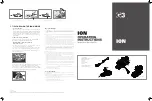
English (Original instructions)
WarninG
If you do not engage the throttle in 4 seconds after
pressing the safety button, you have to press
the safety button again.
movinG forWarD/reverse
See figure 6
Select forward/reverse.
Select high/low speed.
Push safety button. (There is a 4-seconds lead time to
engage step 4.) If the throttle is not engaged within 4
seconds, the unit will not start and safety button needs
to be engaged again.
Engage the throttle to start the garden cart.
Move in reverse only for short distances. If you have a
long distance to travel, turn your garden cart around and
go forward.
WarninG
When moving in reverse, be ready for the garden cart to
lurch towards you and get immediately up to speed. Be
careful; step back and be prepared to walk backwards.
Consider standing to the side of the garden cart until you
get used to moving backwards.
stoppinG
See figure 7
Release the throttle.
Set the power switch to the red dot position. Remove
the battery and store in a safe place to prohibit
unauthorized use of the garden cart.
NOTE: The self-propelled garden cart does not have a
braking system. Instead, to stop your garden cart, you
simply release the throttle. Because of its momentum, your
garden cart might continue to move a bit after you release
the throttle. Don’t let go of the handle until your garden cart
stops completely. Park your garden cart in a level area so
it doesn’t roll away.
unloaDinG Your WheelB arroW
See figure 8
Stop the garden cart
Squeeze the release lever (13) on the bucket to release
the bucket.
Grasp the handles on the bucket to raise and unload
the bucket.
maintenance anD repair
Like any machine, maintaining your garden cart ensures
its best performance and extends its life. Follow these
procedures to keep your garden cart working at peak
efficiency.
Check all screws and nuts regularly; tighten them as
needed. Regularly check the plastic parts for cracks or
broken pieces.
Periodically check the tire pressure on all three tires.
Keep the tire pressure between 28 and 30 pounds per
square inch (psi). The garden cart’s tire valves work
like those on bicycle tires. To add air, remove the cap
and push the air hose or pump fitting onto the end of
the valve stem. To remove air, depress the pin in the
center of the valve stem.
WarninG
Never over inflate the tires. If you over inflate the tires,
you could cause them to explode resulting in severe
injury.
Try not to use your garden cart when it’s wet or snowy.
And do not spray the electrical areas of your garden
cart with a hose. Water and moisture in the motors
and electrical switches can cause them to corrode,
which then causes them to fail. Remember, this is an
electrical machine!
That said; you can still hose off your garden cart. Just
be careful not to spray water directly on the Control
Panel or through the battery cover.
Wash your garden cart using a mild automotive type
detergent and water with a soft brush or rag. Do not
use any alkaline-based soaps or pressure wash your
garden cart.
storinG Your GarDen cart
WarninG
When you store your garden cart, follow these important
guidelines to help ensure your garden cart’s best
performance when you use it again.
Store your garden cart inside or under a protective
cover.
Charge the battery before storing your garden cart.
In temperatures lower then 40° F (5° C), the battery
maintains a charge for about 60 days. If you store your
garden cart for extended periods of time, periodically
recharge the battery. Once a month is a good rule of
thumb.
Always store your garden cart in an environment where
the temperature is between –10° F (–23° C) and +85°
16
















































